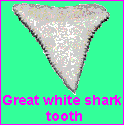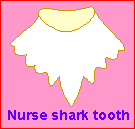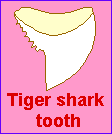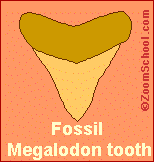Advertisement.
EnchantedLearning.com is a user-supported site.
As a bonus, site members have access to a banner-ad-free version of the site, with print-friendly pages.
Click here to learn more.
(Already a member? Click here.)
 | SHARK ANATOMY |  |
SHARK TEETH
 Sharks may have up to 3,000 teeth at one time. These teeth are modified placoid scales that have the same structure as a tooth, having an outer layer of enamel, dentine and a central pulp cavity.
Sharks may have up to 3,000 teeth at one time. These teeth are modified placoid scales that have the same structure as a tooth, having an outer layer of enamel, dentine and a central pulp cavity.
Most sharks do not chew their food, but gulp it down whole it in large pieces. Their teeth are not able to chew food, but only to tear it into mouth-sized pieces. Some bottom dwellers crush the shell of their prey, but still do not thoroughly chew the food like we do.
SHAPES
Sharks teeth come in many different shapes and sizes, as they are used to catch and kill different prey.
 Some sharks have teeth that are very sharp, wide, wedge-shaped, and serrated (having a jagged edge), designed for catching and tearing apart prey (for example, the great white shark, the tiger shark, the hammerhead and the bull shark). There is a formula for calculating the size of a shark based on the size of triangular tooth: measure the length of one side of the tooth in inches, then multiply by ten to get the total length of the shark in feet.
Some sharks have teeth that are very sharp, wide, wedge-shaped, and serrated (having a jagged edge), designed for catching and tearing apart prey (for example, the great white shark, the tiger shark, the hammerhead and the bull shark). There is a formula for calculating the size of a shark based on the size of triangular tooth: measure the length of one side of the tooth in inches, then multiply by ten to get the total length of the shark in feet.
 Some sharks have thin, sharp, knife-like teeth designed to catch and hold slippery fish (for example, the lemon shark and mako shark).
Some sharks have thin, sharp, knife-like teeth designed to catch and hold slippery fish (for example, the lemon shark and mako shark).
 Many bottom-dwelling sharks have thick conical or flattened teeth in the back of their mouths that are used for crushing crabs and mollusks (for example, the nurse shark, Port Jackson shark, angelshark, and zebra horn shark).
Many bottom-dwelling sharks have thick conical or flattened teeth in the back of their mouths that are used for crushing crabs and mollusks (for example, the nurse shark, Port Jackson shark, angelshark, and zebra horn shark).
REPLACEABLE TEETH
 The teeth are arranged in rows; when one tooth is damaged or lost, it is replaced by another. Most sharks have about 5 rows of teeth at any time.
The teeth are arranged in rows; when one tooth is damaged or lost, it is replaced by another. Most sharks have about 5 rows of teeth at any time.  The front set is the largest and does most of the work. Behind the front row of teeth is a second smaller row of teeth, then a third row, and a fourth and a fifth. The last row of teeth, the smallest, is positioned almost flat against the shark's mouth. As a front tooth is broken or worn down, it falls out and is replaced by a tooth in the next row. The sets of teeth rotate forward and a new tooth forms in the rear.
The front set is the largest and does most of the work. Behind the front row of teeth is a second smaller row of teeth, then a third row, and a fourth and a fifth. The last row of teeth, the smallest, is positioned almost flat against the shark's mouth. As a front tooth is broken or worn down, it falls out and is replaced by a tooth in the next row. The sets of teeth rotate forward and a new tooth forms in the rear.
The front-row teeth of the nurse shark are replaced every 10-14 days in the summer when the shark is actively feeding, and every one to two months in the winter when the shark is less active.
FOSSILIZED TEETH
 Sharks teeth are the most likely part of its body to fossilize since they're composed of bone. Many fossilized sharks teeth have been found, including that of megalodon. Megalodon (Carcharodon megalodon) was an ancient, meat-eating shark, living between 25-1.6 million years ago; it is extinct. It was over 40 feet (12 m) long, but this is only an estimate from fossil teeth that have been found. Its teeth resemble those of the great white shark but are almost 3 times larger.
Sharks teeth are the most likely part of its body to fossilize since they're composed of bone. Many fossilized sharks teeth have been found, including that of megalodon. Megalodon (Carcharodon megalodon) was an ancient, meat-eating shark, living between 25-1.6 million years ago; it is extinct. It was over 40 feet (12 m) long, but this is only an estimate from fossil teeth that have been found. Its teeth resemble those of the great white shark but are almost 3 times larger.
Enchanted Learning®
Over 35,000 Web Pages
Sample Pages for Prospective Subscribers, or click below
Click to read our Privacy Policy
Enchanted Learning Search
|
Search the Enchanted Learning website for:
|
Advertisement.
Advertisement.
Copyright ©1998-2018
EnchantedLearning.com ------ How to cite a web page

